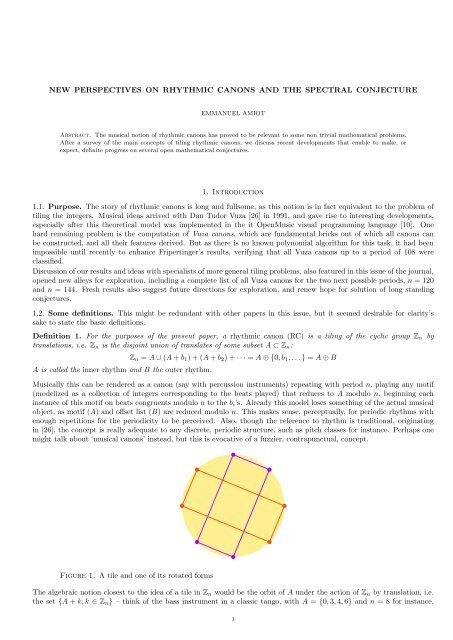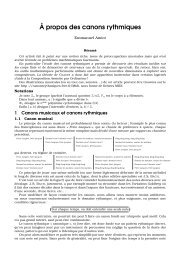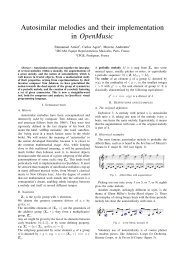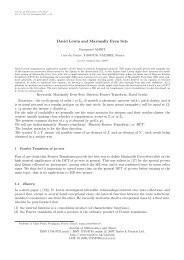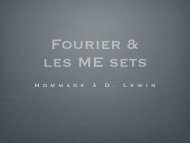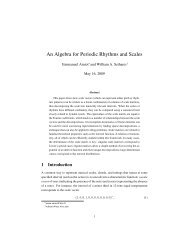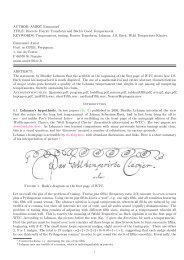Emmanuel Amiot Modèles algébriques et algorithmes pour la ...
Emmanuel Amiot Modèles algébriques et algorithmes pour la ...
Emmanuel Amiot Modèles algébriques et algorithmes pour la ...
Create successful ePaper yourself
Turn your PDF publications into a flip-book with our unique Google optimized e-Paper software.
NEW PERSPECTIVES ON RHYTHMIC CANONS AND THE SPECTRAL CONJECTURE<br />
EMMANUEL AMIOT<br />
Abstract. The musical notion of rhythmic canons has proved to be relevant to some non trivial mathematical problems.<br />
After a survey of the main concepts of tiling rhythmic canons, we discuss recent developments that enable to make, or<br />
expect, definite progress on several open mathematical conjectures.<br />
1. Introduction<br />
1.1. Purpose. The story of rhythmic canons is long and fullsome, as this notion is in fact equivalent to the problem of<br />
tiling the integers. Musical ideas arrived with Dan Tudor Vuza [26] in 1991, and gave rise to interesting developments,<br />
especially after this theor<strong>et</strong>ical model was implemented in the it OpenMusic visual programming <strong>la</strong>nguage [10]. One<br />
hard remaining problem is the computation of Vuza canons, which are fundamental bricks out of which all canons can<br />
be constructed, and all their features derived. But as there is no known polynomial algorithm for this task, it had been<br />
impossible until recently to enhance Fripertinger’s results, verifying that all Vuza canons up to a period of 108 were<br />
c<strong>la</strong>ssified.<br />
Discussion of our results and ideas with specialists of more general tiling problems, also featured in this issue of the journal,<br />
opened new alleys for exploration, including a compl<strong>et</strong>e list of all Vuza canons for the two next possible periods, n = 120<br />
and n = 144. Fresh results also suggest future directions for exploration, and renew hope for solution of long standing<br />
conjectures.<br />
1.2. Some definitions. This might be redundant with other papers in this issue, but it seemed desirable for c<strong>la</strong>rity’s<br />
sake to state the basic definitions.<br />
Definition 1. For the purposes of the present paper, a rhythmic canon (RC) is a tiling of the cyclic group Zn by<br />
trans<strong>la</strong>tions, i.e. Zn is the disjoint union of trans<strong>la</strong>tes of some subs<strong>et</strong> A ⊂ Zn:<br />
A is called the inner rhythm and B the outer rhythm.<br />
Zn = A ∪ (A + b1) + (A + b2) + · · · = A ⊕ {0, b1, . . . } = A ⊕ B<br />
Musically this can be rendered as a canon (say with percussion instruments) repeating with period n, p<strong>la</strong>ying any motif<br />
(modelized as a collection of integers corresponding to the beats p<strong>la</strong>yed) that reduces to A modulo n, beginning each<br />
instance of this motif on beats congruents modulo n to the bi’s. Already this model loses som<strong>et</strong>hing of the actual musical<br />
object, as motif (A) and offs<strong>et</strong> list (B) are reduced modulo n. This makes sense, perceptually, for periodic rhythms with<br />
enough rep<strong>et</strong>itions for the periodicity to be perceived. Also, though the reference to rhythm is traditional, originating<br />
in [26], the concept is really adequate to any discr<strong>et</strong>e, periodic structure, such as pitch c<strong>la</strong>sses for instance. Perhaps one<br />
might talk about ‘musical canons’ instead, but this is evocative of a fuzzier, contrapunctual, concept.<br />
Figure 1. A tile and one of its rotated forms<br />
The algebraic notion closest to the idea of a tile in Zn would be the orbit of A under the action of Zn by trans<strong>la</strong>tion, i.e.<br />
the s<strong>et</strong> {A + k, k ∈ Zn} – think of the bass instrument in a c<strong>la</strong>ssic tango, with A = {0, 3, 4, 6} and n = 8 for instance.<br />
1


